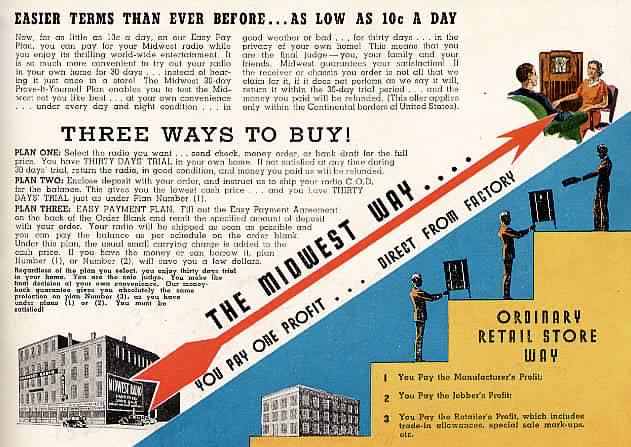
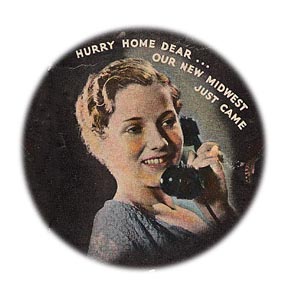
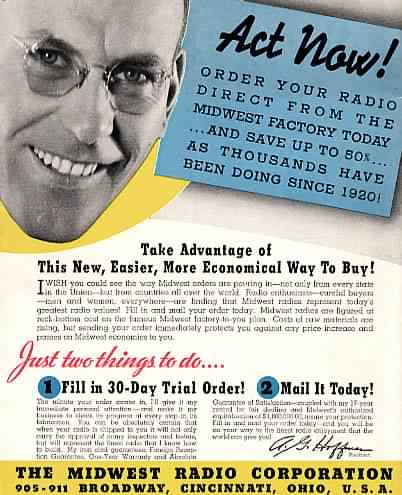
A
BIT ABOUT
THE
MIDWEST
RADIO
COMPANY
AND THEIR
PRODUCTS
The
Midwest
radio
Corporation,
founded by
E.G.
Hoffman,
had its
beginnings
as early
as 1920.
Headquartered
in
Cincinnati
Ohio, they
basically
produced
the entire
radio in
their
factory
(or
laboratories
as it was
called)
including
the
cabinets
and the
winding of
their own
transformers
and coils.
The
company
hit upon
the idea
of selling
their
products
by mail
order
directly
from their
laboratories
thus
eliminating
the
middleman
markup and
saving the
consumer
money.



By offering credit terms, trade in allowances, free home trials, gifts, user-agents and other incentives, the company appears to have been quite successful claiming over 120,000 customers by 1936.
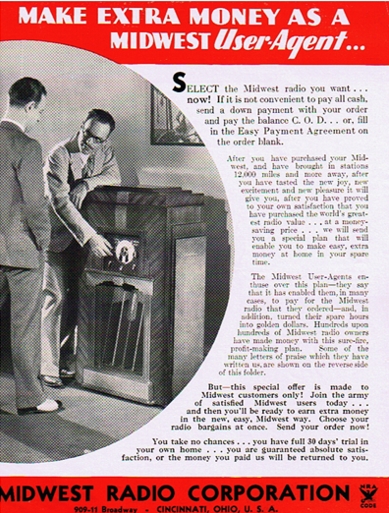
It
does
appear
that
sometime
after
World War
II sales
started to
decline as
it did for
many mail
order
business
and by
1957 or
there
about,
the
company
ceased to
exist.
Shown here
is the
1956
Midwest
Radio and
Television
catalog.
The
catalog is
similar to
Sears or
Montgomery
Wards in
that they
are
offering
many home
products
such as
luggage,
jewelry
and,
appliances
at
discount
prices. No
Midwest
radios are
shown and
only a few
Midwest
televisions.
Obviously
a last
gasp
effort to
stay in
business.
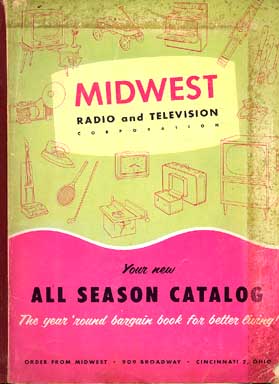


Today the huge Midwest Radio Company laboratory is gone and a parking lot has taken it's place.

From their early battery and electric sets to the introduction of television the Midwest Radio company kept abreast of the latest radio developments. Cabinet styling was often dramatic and innovative and some design features held US patents such as the 1936 'V-Front' which incorporated sound diverting louvers placed behind the speaker grille.
Another company feature was that a customer could purchase a chassis and matching speaker only, no cabinet. The chassis came with an integral faceplate which allowed for easy installation into the customers existing cabinet. This helps explain why it is not uncommon to find a Midwest chassis mounted in a cabinet of a different make.
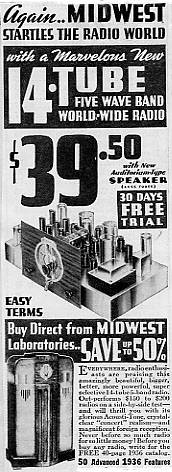
Midwest radios were inexpensive compared to many other makes. For example, an 8 tube 1937 Zenith console may have a suggested price of $89.95 The catalog price of an 18 tube Midwest console started at just $89.50 complete.
Heavy advertising like this one gave the impression of an extremely low price due to the fact that it was a bit misleading. In this ad, one has the impression that the set pictured is $39.50 but that price is for the chassis and speaker only, not the complete console shown. I'm sure that other radio companies did the same thing.
Midwest
also
offered
low priced
radio
specials
from time
to time.
For
instance,
in a
"Special
Sale"
mailer
sent to
prospective
customers,
selected
1938
cabinets
fitted
with 1937
chassies
were
"available
for a
limited
time
only".
I have
also seen
examples
of current
model year
chassies
fitted
into prior
year
cabinets.
These
specials
seemed to
be a way
to use up
left over
cabinets
and
chassies.Obviously
there had
to be some
shortcuts
for
Midwest to
be able to
sell a
radio set
for such
low
prices. I
have found
that much
of this
was in the
cabinet.
While a
wide
variety of
exotic
wood
veneers
was used
to produce
outstanding
looks, the
cabinet
construction
was quick
and dirty.
For
instance,
there are
usually no
screws
used in
the
construction
of the
cabinets,
just glue
and nails.
The
extensive
use of
dark
colored
lacquers
on corners
hide
exposed
edges of
the
plywood
panels and
nail
holes. The
lacquer
finish was
also thin
in
comparison
to that of
a Philco
for
example.
Other
money
saving
techniques
were no
dial glass
and
usually a
minimum of
parts used
in the
chassis
design.
A
word on
electronic
and
chassis
design.
Through
the years
I have
heard
radio
collectors
say that
many of
the tubes
in a
Midwest
served no
purpose
and that
some were
not even
connected.
I have
never
found this
to be
true; each
tube has a
purpose.
Granted it
may be a
duplicate
function
such as 2
rectifier
tubes or 4
tubes used
in the
output
stages,
but all do
something.
My usual
response
to the
comment
"you
can pull
out some
of the
tubes and
it will
still
play"
is to ask
if they
have ever
tried the
same thing
with a big
Scott or
15 tube
Zenith.
This makes
them think
because,
it will
still play
too!

Agreed,
the
Midwest
was not
necessarily
the
highest
quality
radio but
nor was it
the worst.
It was I
believe, a
great
bargain
for the
money
offering
many
features
available
only in
much
higher
priced
radios of
the time.
I know
many
collectors
that will
tell you
their
Midwest
performs
as good or
better
than any
other set
in their
collections.
Just ask
them.